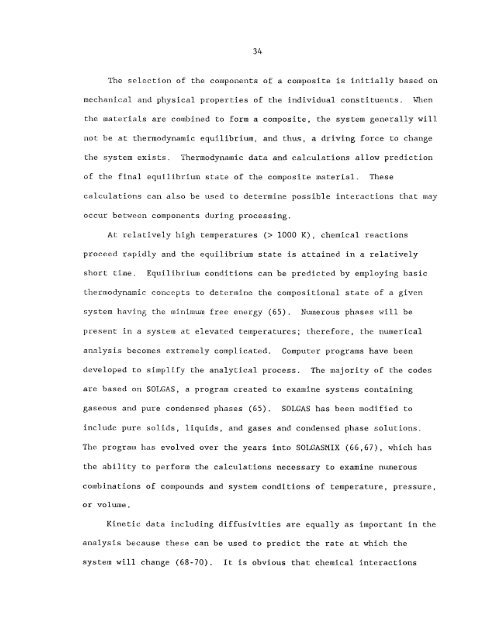Characterization and control of the fiber-matrix interface in ceramic ...
Characterization and control of the fiber-matrix interface in ceramic ...
Characterization and control of the fiber-matrix interface in ceramic ...
You also want an ePaper? Increase the reach of your titles
YUMPU automatically turns print PDFs into web optimized ePapers that Google loves.
34<br />
The selection <strong>of</strong> <strong>the</strong> co<strong>in</strong>ponents <strong>of</strong> a composite is <strong>in</strong>itially based on<br />
mechanical. <strong>and</strong> physical properties <strong>of</strong> <strong>the</strong> <strong>in</strong>dividual constituents. When<br />
<strong>the</strong> materials are cornbi-ned to form a composite, <strong>the</strong> system generally will.<br />
not be at <strong>the</strong>rmodynamic equilibrium, <strong>and</strong> thus, a driv<strong>in</strong>g force to change<br />
<strong>the</strong> system exists. Thermodynamic data <strong>and</strong> calculations allow prediction<br />
<strong>of</strong> <strong>the</strong> f<strong>in</strong>al equilibrium state <strong>of</strong> <strong>the</strong> composite material. These<br />
calculations can also be used to determ<strong>in</strong>e possible <strong>in</strong>teractions that may<br />
occur between components dur<strong>in</strong>g process<strong>in</strong>g.<br />
At relatively high temperatures (> 1000 K), chemical reactions<br />
proceed rapidly <strong>and</strong> <strong>the</strong> equilibrium state is atta<strong>in</strong>ed <strong>in</strong> a relatively<br />
short <strong>the</strong>.<br />
Equi.1.i.brium conditions can be predicted by employ<strong>in</strong>g basic<br />
<strong>the</strong>rmodynamic concepts to detc?rmi.ne <strong>the</strong> compositional state <strong>of</strong> a given<br />
system hav<strong>in</strong>g <strong>the</strong> m<strong>in</strong>imum free energy (65).<br />
Nu<strong>in</strong>erous phases wi.11 be<br />
present <strong>in</strong> a system at elevated temperatures; <strong>the</strong>refore, <strong>the</strong> numerical<br />
analysis becomes extremely complicated.<br />
Computer programs have been<br />
developed to simplify <strong>the</strong> analytical process.<br />
The majority <strong>of</strong> <strong>the</strong> codes<br />
are based on SOLGAS, a program created to exam<strong>in</strong>e systems conta<strong>in</strong><strong>in</strong>g<br />
gaseous <strong>and</strong> pure condensed phases (65).<br />
SOLGAS has been modified to<br />
<strong>in</strong>clude pure solids, liquids, <strong>and</strong> gases <strong>and</strong> condensed phase solutions.<br />
The program has evolved over <strong>the</strong> years <strong>in</strong>to SOLGASMIX (06,67), which has<br />
<strong>the</strong> ability to perform <strong>the</strong> calculations necessary to exam<strong>in</strong>e numerous<br />
comb<strong>in</strong>ations <strong>of</strong> compounds <strong>and</strong> system conditions <strong>of</strong> temperature, pressure,<br />
or volume.<br />
K<strong>in</strong>etic data <strong>in</strong>clud<strong>in</strong>g diffusivities are equally as important <strong>in</strong> <strong>the</strong><br />
analysis because <strong>the</strong>se can be used to predict <strong>the</strong> rate at which <strong>the</strong><br />
system will change (68-70). It is obvious that chemical <strong>in</strong>teractions

















